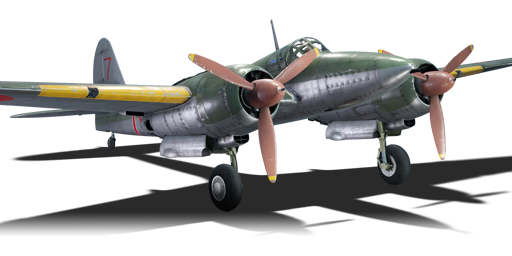



The Ki-108 Kai was a Japanese twin-engine heavy fighter/interceptor prototype developed from the Ki-96 and Ki-102 models. It was designed to counter the high-altitude American bombers such as the B-29 Superfortress. It had a pressurized cockpit, a 37 mm nose cannon and two 20 mm chin cannons. It was powered by two Mitsubishi Ha-112-II Ru turbosupercharged radial engines. Only four Ki-108s were built and none saw combat before the end of the war.
It was introduced in Update 1.77 "Advancing Storm". The Ki-108 is a formidable heavy fighter that boasts strong armament, respectable climb performance, and reasonable manoeuvrability. Its main drawback is its vulnerable engines that can be crippled by enemy fire. The optimal strategy for this plane is to intercept bombers from the front or side and evade their rear gunners. The plane can also handle fighters that are lower than it, but it should not challenge them on equal footing, as it lacks dogfighting and escape capabilities. The plane should climb to the side of the map and have friendly cover above it. If the plane faces enemy fighters at high altitude without allies, it should be cautious and strike when they are unsuspecting.
flaps
flaps
flaps
brake
| Belt | Belt filling | Armor penetration (mm) at a distance: | |||||
|---|---|---|---|---|---|---|---|
| 10 m | 100 m | 500 m | 1000 m | 1500 m | 2000 m | ||
| HEFI-T/P | 51 | 49 | 43 | 37 | 31 | 27 | |
| P | 51 | 49 | 43 | 37 | 31 | 27 | |
| HEFI-T | 5 | 4 | 3 | 3 | 3 | 3 | |
| Belt | Belt filling | Armor penetration (mm) at a distance: | |||||
|---|---|---|---|---|---|---|---|
| 10 m | 100 m | 500 m | 1000 m | 1500 m | 2000 m | ||
| HEF-I/P/AP-T | 27 | 25 | 17 | 10 | 6 | 4 | |
| HEF-I/HEF-I/AP-T | 27 | 25 | 17 | 10 | 6 | 4 | |
| AP-T/AP-T/HEF-I | 27 | 25 | 17 | 10 | 6 | 4 | |
| AP-T | 27 | 25 | 17 | 10 | 6 | 4 | |
| HEF-I/HEF-I/HEF-I/P | 16 | 13 | 8 | 6 | 0 | 0 | |












Flight performance | |
|---|---|
Survivability |
|---|
Weaponry |
|---|